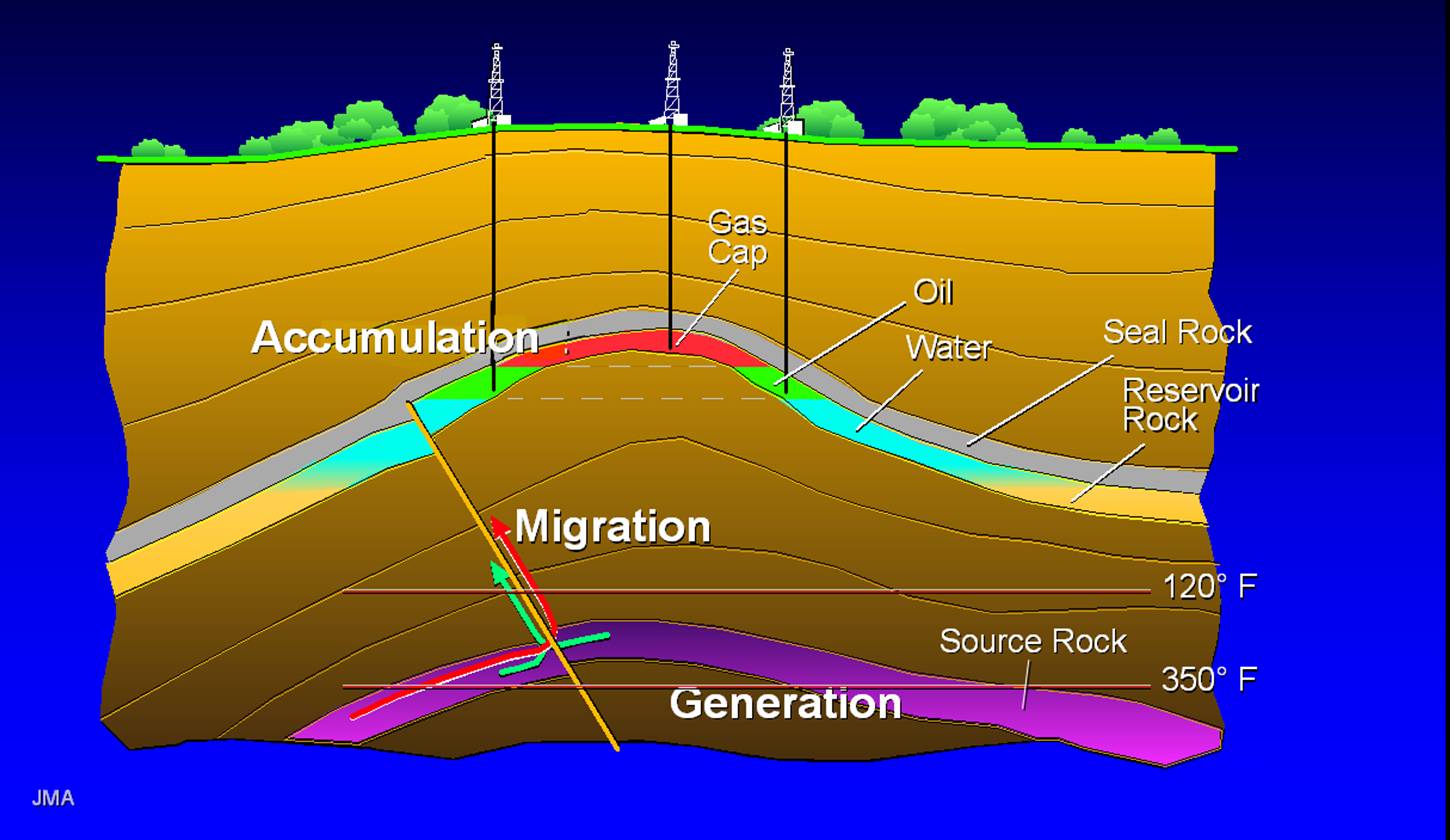Preface
Petroleum system consist of source rock, reservoir, seal/cap rock, trap, migration, and maturity.
a. Source rock : Source of the oil, usually limestone and shale. Source rock has many organic material from reefs, planctonic, etc.
b. Reservoir : porous and permeable lithological unit or set of units that holds the hydrocarbon reserves. Analysis of reservoirs at the simplest level requires an assessment of their porosity (to calculate the volume of in situ hydrocarbons) and their permeability (to calculate how easily hydrocarbons will flow out of them).
c. Cap Rock : unit with low permeability that impedes the escape of hydrocarbons from the reservoir rock. Common seals include evaporites, chalks and shales. Analysis of seals involves assessment of their thickness and extent, such that their effectiveness can be quantified
d. Trap : trap is the stratigraphic or structural feature that ensures the juxtaposition of reservoir and seal such that hydrocarbons remain trapped in the subsurface, rather than escaping (due to their natural buoyancy) and being lost.
e. Migration : oil moves from source rock, then fill in reservoir pore and trapped
f. maturity : to make predictions of the amount and timing of hydrocarbon generation and expulsion
Petroleum system consist of source rock, reservoir, seal/cap rock, trap, migration, and maturity.
a. Source rock : Source of the oil, usually limestone and shale. Source rock has many organic material from reefs, planctonic, etc.
b. Reservoir : porous and permeable lithological unit or set of units that holds the hydrocarbon reserves. Analysis of reservoirs at the simplest level requires an assessment of their porosity (to calculate the volume of in situ hydrocarbons) and their permeability (to calculate how easily hydrocarbons will flow out of them).
c. Cap Rock : unit with low permeability that impedes the escape of hydrocarbons from the reservoir rock. Common seals include evaporites, chalks and shales. Analysis of seals involves assessment of their thickness and extent, such that their effectiveness can be quantified
d. Trap : trap is the stratigraphic or structural feature that ensures the juxtaposition of reservoir and seal such that hydrocarbons remain trapped in the subsurface, rather than escaping (due to their natural buoyancy) and being lost.
e. Migration : oil moves from source rock, then fill in reservoir pore and trapped
f. maturity : to make predictions of the amount and timing of hydrocarbon generation and expulsion
http://smiatmiundip.files.wordpress.com/2011/05/migrasi.jpg
Mechanism (of the figure)
Source rock which has organic material (planctonic, algae, etc) produce the oil because the temperature make it mature. Then the oil moves into reservoir through the fault and fill the pore (migration). Then after the migration happens, it will be trapped and accumulated. The density of oil < density of water, accordingly oil always on the top of the water. When the oil reach the specific point, it will be gas.
Why the oil/gas not leak to the surface?
Why the oil/gas not leak to the surface?
Because the top of reservoir rock, there are seals rock. Seal consist of impermeable rock, usually claystone. and the top of seal named overburden rock.
Trap
There are kinds of oil/gas trap
Structural Trap : formed by a deformation in the rock layer that contains the hydrocarbons. There are salt dome, fold, and fault trap. Structural traps are the easiest to locate by surface and subsurface geological and geophysical studies. They are the most numerous among traps and have received a greater amount of attention in the search for oil than all other types of traps.
- Salt Dome Trap : Intrusion of salt because of differential density of rock layer and salt. Salt will tends cut the top layer on it. Then, it makes a trap for oil accumulation.
 http://www.cartografareilpresente.org/local/cache-vignettes/L300xH232/Salt_dome_trap-42877.jpg
http://www.cartografareilpresente.org/local/cache-vignettes/L300xH232/Salt_dome_trap-42877.jpg - Fold Trap : Compression of tectonics make rock layers folded and forms sincline and anticline. Anticline is the best trap, because the drilling process is relatively easy. The oil and gas move to the top because pressure, and drilling started on the topper of anticline because of eficiency height.
3. Fault Trap : Trap formed by fault (look at the figure on top), and the oil could not to moves because there was impermeable layer
Stratigraphic Trap : formed when other beds seal a reservoir bed or when the permeability changes (facies change) within the reservoir bed itself. Stratigraphic traps can form against either younger or older time surfaces.
Source :
http://en.wikipedia.org/wiki/Petroleum_geology
http://en.wikipedia.org/wiki/Petroleum_reservoir
keywords : Petroleum system, trap, reservoir, source rock, structural trap, seal rock, petroleum geology, migration, fault

No comments:
Post a Comment